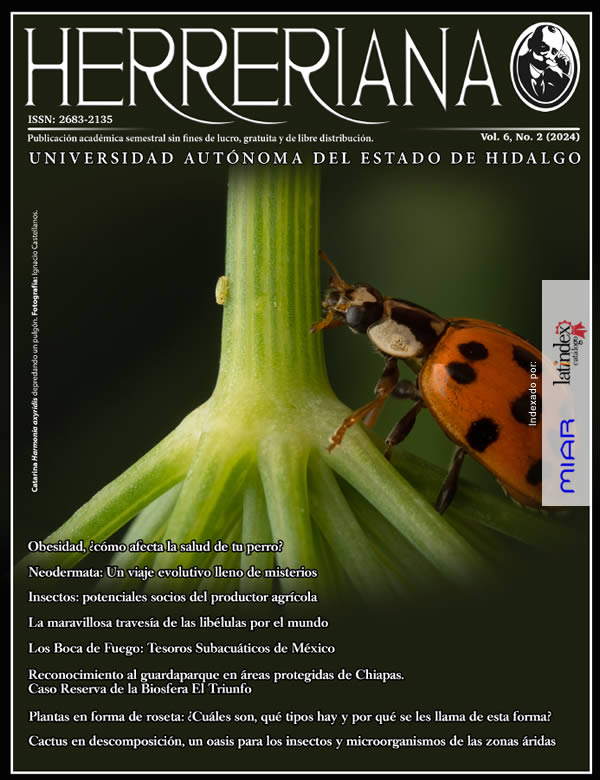Neodermata: Un viaje evolutivo lleno de misterios
DOI:
https://doi.org/10.29057/h.v6i2.12024Palabras clave:
Platelmintos, Genómica, Evolución, FilogeniaResumen
Los Neodermata son gusanos planos parásitos que tienen un papel relevante en temas de salud pública y veterinaria. Aunque se ha investigado mucho sobre ellos, varios aspectos de su historia evolutiva siguen siendo un misterio. La investigación tradicional se basaba en su anatomía, pero con avances tecnológicos, el análisis del ADN ha revelado nuevas conexiones entre diferentes especies. Estos parásitos se dividen en tres clases principales: Monogenea, Trematoda y Cestoda. Cada una tiene adaptaciones únicas que les permiten prosperar en sus respectivos ambientes y hospederos. Las hipótesis sobre sus raíces evolutivas son diversas y continúan en discusión. Estos parásitos son ejemplos sorprendentes de adaptación y evolución, y su estudio es relevante para el desarrollo de tratamientos antiparasitarios.
Descargas
Información de Publicación
Perfiles de revisores N/D
Declaraciones del autor
Indexado en
- Sociedad académica
- N/D
- Editora:
- Universidad Autónoma del Estado de Hidalgo
Citas
Caña-Bozada, V. H., Robinson, M. W., Hernández-Mena, D. I., & Morales-Serna, F. N. (2023). Exploring Evolutionary Relationships within Neodermata Using Putative Orthologous Groups of Proteins, with Emphasis on Peptidases. Tropical Medicine and Infectious Disease, 8(1), 59. https://doi.org/10.3390/tropicalmed8010059
Lefèvre, T., Lebarbenchon, C., Gauthier-Clerc, M., Missé, D., Poulin, R., & Thomas, F. (2009). The ecological significance of manipulative parasites. Trends in Ecology & Evolution, 24(1), 41-48. https://doi.org/10.1016/j.tree.2008.08.007
Littlewood, D. T. J., Rohde, K., Bray, R. A., & Herniou, E. A. (1999a). Phylogeny of the Platyhelminthes and the evolution of parasitism. Biological Journal of the Linnean Society, 68(1-2), 257-287. https://doi.org/10.1111/j.1095-8312.1999.tb01169.x
Littlewood, D. T. J., Rohde, K., & Clough, K. A. (1999b). The interrelationships of all major groups of Platyhelminthes: Phylogenetic evidence from morphology and molecules. Biological Journal of the Linnean Society, 66(1), 75-114. https://doi.org/10.1111/j.1095-8312.1999.tb01918.x
Lockyer, A. E., Olson, P. D., & Littlewood, D. T. J. (2003). Utility of complete large and small subunit rRNA genes in resolving the phylogeny of the Neodermata (Platyhelminthes): Implications and a review of the cercomer theory. Biological Journal of the Linnean Society, 78(2), 155-171. https://doi.org/10.1046/j.1095-8312.2003.00141.x
Park, J. K., Kim, K. H., Kang, S., Kim, W., Eom, K. S., & Littlewood, D. T. J. (2007). A common origin of complex life cycles in parasitic flatworms: Evidence from the complete mitochondrial genome of Microcotyle sebastis (Monogenea: Platyhelminthes). BMC Evolutionary Biology, 7(11), 1-13. https://doi.org/10.1186/1471-2148-7-11
Perkins, E. M., Donnellan, S. C., Bertozzi, T., & Whittington, I. D. (2010). Closing the mitochondrial circle on paraphyly of the Monogenea (Platyhelminthes) infers evolution in the diet of parasitic flatworms. International Journal for Parasitology, 40(11), 1237-1245. https://doi.org/10.1016/j.ijpara.2010.02.017
Thomas, F., & Poulin, R. (1998). Manipulation of a mollusc by a trophically transmitted parasite: Convergent evolution or phylogenetic inheritance? Parasitology, 116(5), 431-436. https://doi.org/10.1017/S003118209800239X


















